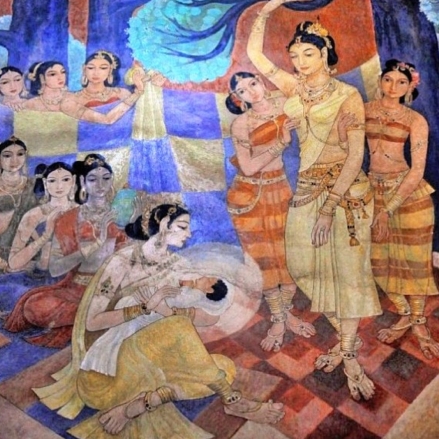Every life has a beginning and an end. Birth would seem to be a part of life common to all lives, including the Buddha’s. The Buddha was born, of course, and he also died, but what is distinctive to him happened in between: his leaving home, his awakening, his first sermon, and so on. It may seem that those events are the most important parts of his life. Many of the biographies of the Buddha that we receive from different Buddhist traditions treat his birth in the same way as they treat those parts that are distinctive to his life. These received biographies say that all of these distinctive events were accompanied by earthquakes, but so were his birth and his death. Even the facts of his birth are described with the luminosity of miracles, from conception to delivery. In short, the Buddha’s whole life, starting from his birth, was traced in mythic outlines which highlighted just how different his life was from all other lives.
To see things mythically is to see our world in depth. But there are other depths in the world, all-too-human depths, and these may be depths that myth captures less well, as is obvious in this song about another key part of the story of the Buddha’s birth: the death of his mother just a few days after his birth.
This is as dramatic a part of the story as any of the mythic parts, but it is a story of loss and grief, not wonder and celebration. We can ask if this part of the Buddha’s biography preserves some kernel of historical fact; why would anyone make up such an event to insert into the Buddha’s biography if it wasn’t something commonly remembered?
This song, in its sounds and in its contents, focuses our attention on this moment of loss and grief as it draws us into an emotional scene in which a dying mother, Maya, asks her younger sister, Gotami, to take care of her newborn son after her death, which she knows is close at hand.
This song is from a long tradition of Cambodian Dharma songs that continues to the present day. When we listen to the song, it is easy to affirm the comment of Trent Walker, the singer in the recording here and the scholar who has done the most to make accessible the Cambodian Dharma song tradition, that “The Cambodian Dharma song tradition brings to life the voices of women instrumental in the Buddha’s life, including his wife, mother, and stepmother” (http://www.stirringandstilling.org/s11.html).
As our empathy encourages us to move inside this song, to witness, as it were, Maya asking her younger sister to do what she knows she will not be able to do herself, we may want to keep in mind the insight that Koet Ran, one of Trent Walker’s Cambodian teachers, shared with him about these Dharma songs: they “allow us to contemplate our existence” (http://www.stirringandstilling.org/introduction.html).
Some key Buddhist ideas are voiced in the song that can help to deepen such reflections. At one point, Maya says to her sister,
- Life is as the Pali phrase
- ANICCAM DUKKHAM ANATTA
- Little darling you must know.
Aniccam is the impermanence of all things, dukkham is the inevitable suffering that characterizes all life in this world, and anatta names the absence of anything enduring, such as a soul, in any life. These three ideas are central to what the Theravada Buddhist tradition, the Buddhist tradition found in Cambodia, remembers as the teaching of the Buddha. These ideas stand out in the song because they are in the Pali language, the language used in the scriptures of the Theravada tradition, while the rest of the song is in the Khmer language. When these three ideas are brought together, as here, they constitute the three defining characteristics of the world, or tilakkhana in Pali. It is noteworthy that Maya already knows by painful experience what her son would later teach as the Buddha.
Equally noteworthy is Maya’s lament, “No more can I hold my son, the refuge of gods and men.” Maya’s description of her son as “the refuge of gods and men” evokes a standard epithet of the Buddha which names one of his excellences and thus the words of her lament anticipate what her son will become and what he already is for all who hear this song.
